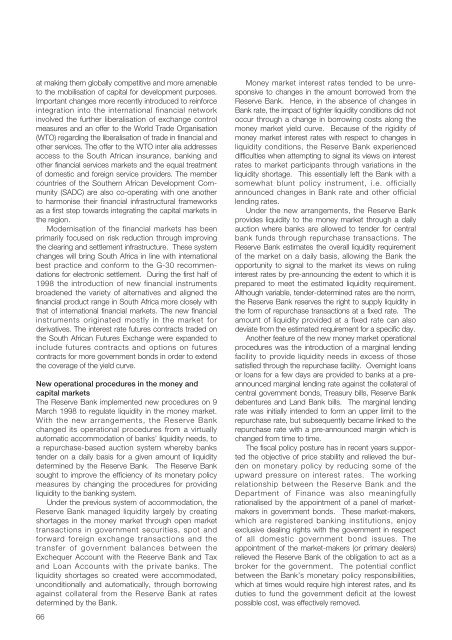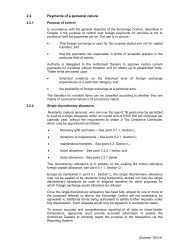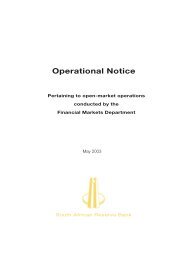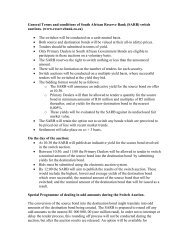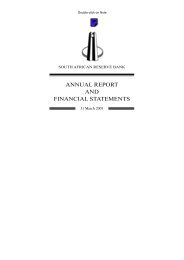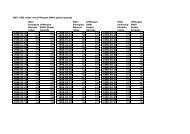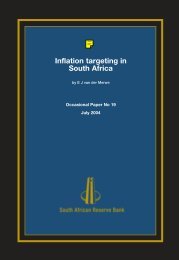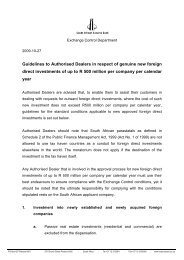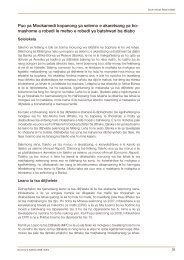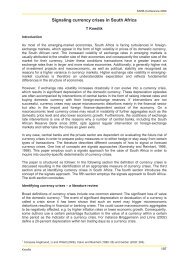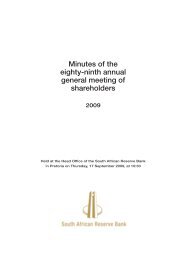Article: Quarterly Bulletin - South African Reserve Bank
Article: Quarterly Bulletin - South African Reserve Bank
Article: Quarterly Bulletin - South African Reserve Bank
You also want an ePaper? Increase the reach of your titles
YUMPU automatically turns print PDFs into web optimized ePapers that Google loves.
at making them globally competitive and more amenable<br />
to the mobilisation of capital for development purposes.<br />
Important changes more recently introduced to reinforce<br />
integration into the international financial network<br />
involved the further liberalisation of exchange control<br />
measures and an offer to the World Trade Organisation<br />
(WTO) regarding the liberalisation of trade in financial and<br />
other services. The offer to the WTO inter alia addresses<br />
access to the <strong>South</strong> <strong>African</strong> insurance, banking and<br />
other financial services markets and the equal treatment<br />
of domestic and foreign service providers. The member<br />
countries of the <strong>South</strong>ern <strong>African</strong> Development Community<br />
(SADC) are also co-operating with one another<br />
to harmonise their financial infrastructural frameworks<br />
as a first step towards integrating the capital markets in<br />
the region.<br />
Modernisation of the financial markets has been<br />
primarily focused on risk reduction through improving<br />
the clearing and settlement infrastructure. These system<br />
changes will bring <strong>South</strong> Africa in line with international<br />
best practice and conform to the G-30 recommendations<br />
for electronic settlement. During the first half of<br />
1998 the introduction of new financial instruments<br />
broadened the variety of alternatives and aligned the<br />
financial product range in <strong>South</strong> Africa more closely with<br />
that of international financial markets. The new financial<br />
instruments originated mostly in the market for<br />
derivatives. The interest rate futures contracts traded on<br />
the <strong>South</strong> <strong>African</strong> Futures Exchange were expanded to<br />
include futures contracts and options on futures<br />
contracts for more government bonds in order to extend<br />
the coverage of the yield curve.<br />
New operational procedures in the money and<br />
capital markets<br />
The <strong>Reserve</strong> <strong>Bank</strong> implemented new procedures on 9<br />
March 1998 to regulate liquidity in the money market.<br />
With the new arrangements, the <strong>Reserve</strong> <strong>Bank</strong><br />
changed its operational procedures from a virtually<br />
automatic accommodation of banks’ liquidity needs, to<br />
a repurchase-based auction system whereby banks<br />
tender on a daily basis for a given amount of liquidity<br />
determined by the <strong>Reserve</strong> <strong>Bank</strong>. The <strong>Reserve</strong> <strong>Bank</strong><br />
sought to improve the efficiency of its monetary policy<br />
measures by changing the procedures for providing<br />
liquidity to the banking system.<br />
Under the previous system of accommodation, the<br />
<strong>Reserve</strong> <strong>Bank</strong> managed liquidity largely by creating<br />
shortages in the money market through open market<br />
transactions in government securities, spot and<br />
forward foreign exchange transactions and the<br />
transfer of government balances between the<br />
Exchequer Account with the <strong>Reserve</strong> <strong>Bank</strong> and Tax<br />
and Loan Accounts with the private banks. The<br />
liquidity shortages so created were accommodated,<br />
unconditionally and automatically, through borrowing<br />
against collateral from the <strong>Reserve</strong> <strong>Bank</strong> at rates<br />
determined by the <strong>Bank</strong>.<br />
66<br />
Money market interest rates tended to be unresponsive<br />
to changes in the amount borrowed from the<br />
<strong>Reserve</strong> <strong>Bank</strong>. Hence, in the absence of changes in<br />
<strong>Bank</strong> rate, the impact of tighter liquidity conditions did not<br />
occur through a change in borrowing costs along the<br />
money market yield curve. Because of the rigidity of<br />
money market interest rates with respect to changes in<br />
liquidity conditions, the <strong>Reserve</strong> <strong>Bank</strong> experienced<br />
difficulties when attempting to signal its views on interest<br />
rates to market participants through variations in the<br />
liquidity shortage. This essentially left the <strong>Bank</strong> with a<br />
somewhat blunt policy instrument, i.e. officially<br />
announced changes in <strong>Bank</strong> rate and other official<br />
lending rates.<br />
Under the new arrangements, the <strong>Reserve</strong> <strong>Bank</strong><br />
provides liquidity to the money market through a daily<br />
auction where banks are allowed to tender for central<br />
bank funds through repurchase transactions. The<br />
<strong>Reserve</strong> <strong>Bank</strong> estimates the overall liquidity requirement<br />
of the market on a daily basis, allowing the <strong>Bank</strong> the<br />
opportunity to signal to the market its views on ruling<br />
interest rates by pre-announcing the extent to which it is<br />
prepared to meet the estimated liquidity requirement.<br />
Although variable, tender-determined rates are the norm,<br />
the <strong>Reserve</strong> <strong>Bank</strong> reserves the right to supply liquidity in<br />
the form of repurchase transactions at a fixed rate. The<br />
amount of liquidity provided at a fixed rate can also<br />
deviate from the estimated requirement for a specific day.<br />
Another feature of the new money market operational<br />
procedures was the introduction of a marginal lending<br />
facility to provide liquidity needs in excess of those<br />
satisfied through the repurchase facility. Overnight loans<br />
or loans for a few days are provided to banks at a preannounced<br />
marginal lending rate against the collateral of<br />
central government bonds, Treasury bills, <strong>Reserve</strong> <strong>Bank</strong><br />
debentures and Land <strong>Bank</strong> bills. The marginal lending<br />
rate was initially intended to form an upper limit to the<br />
repurchase rate, but subsequently became linked to the<br />
repurchase rate with a pre-announced margin which is<br />
changed from time to time.<br />
The fiscal policy posture has in recent years supported<br />
the objective of price stability and relieved the burden<br />
on monetary policy by reducing some of the<br />
upward pressure on interest rates. The working<br />
relationship between the <strong>Reserve</strong> <strong>Bank</strong> and the<br />
Department of Finance was also meaningfully<br />
rationalised by the appointment of a panel of marketmakers<br />
in government bonds. These market-makers,<br />
which are registered banking institutions, enjoy<br />
exclusive dealing rights with the government in respect<br />
of all domestic government bond issues. The<br />
appointment of the market-makers (or primary dealers)<br />
relieved the <strong>Reserve</strong> <strong>Bank</strong> of the obligation to act as a<br />
broker for the government. The potential conflict<br />
between the <strong>Bank</strong>’s monetary policy responsibilities,<br />
which at times would require high interest rates, and its<br />
duties to fund the government deficit at the lowest<br />
possible cost, was effectively removed.


